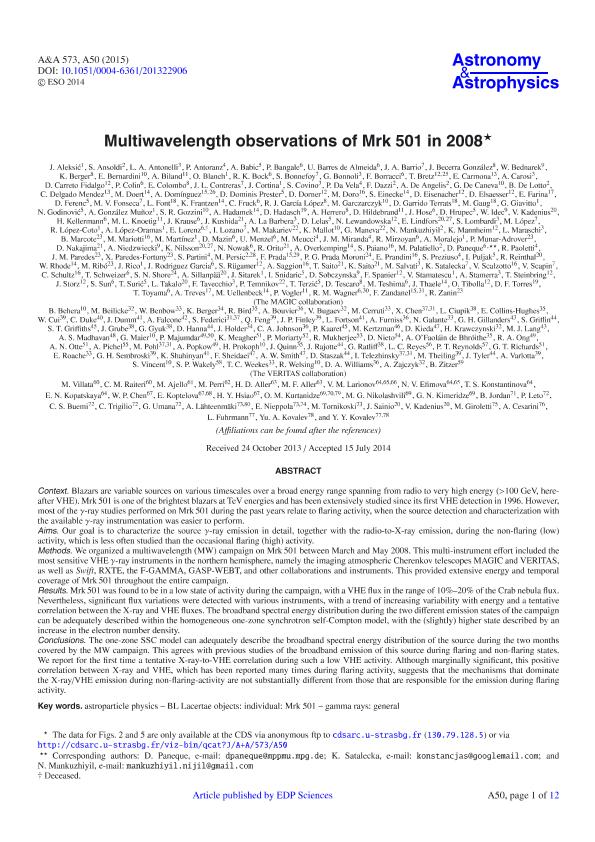Artículo
Multiwavelength observations of Mrk 501 in 2008
Aleksic, J.; Ansoldi, S. ; Antonelli, L. A.; Antoranz, P.; Babic, A.; Bangale, P.; Barres de Almeida, U.; Barrio, J. A.; Becerra Gonzalez, J.; Bednarek, W.; Berger, K.; Bernardini, E.; Biland, A.; Blanch, O.; Bock, R. K.; Bonnefoy, S.; Bonnoli, G.; Borracci, F.; Bretz, T.; Carmona, E.; Carosi, A.; Carreto Fidalgo, D.; Colin, P.; Colombo, E.; Contreras, J. L.; Cortina, J.; Covino, S.; Da Vela, P.; Dazzi, F.; Pichel, Ana Carolina
; Antonelli, L. A.; Antoranz, P.; Babic, A.; Bangale, P.; Barres de Almeida, U.; Barrio, J. A.; Becerra Gonzalez, J.; Bednarek, W.; Berger, K.; Bernardini, E.; Biland, A.; Blanch, O.; Bock, R. K.; Bonnefoy, S.; Bonnoli, G.; Borracci, F.; Bretz, T.; Carmona, E.; Carosi, A.; Carreto Fidalgo, D.; Colin, P.; Colombo, E.; Contreras, J. L.; Cortina, J.; Covino, S.; Da Vela, P.; Dazzi, F.; Pichel, Ana Carolina ; The MAGIC collaboration; The VERITAS collaboration
; The MAGIC collaboration; The VERITAS collaboration
 ; Antonelli, L. A.; Antoranz, P.; Babic, A.; Bangale, P.; Barres de Almeida, U.; Barrio, J. A.; Becerra Gonzalez, J.; Bednarek, W.; Berger, K.; Bernardini, E.; Biland, A.; Blanch, O.; Bock, R. K.; Bonnefoy, S.; Bonnoli, G.; Borracci, F.; Bretz, T.; Carmona, E.; Carosi, A.; Carreto Fidalgo, D.; Colin, P.; Colombo, E.; Contreras, J. L.; Cortina, J.; Covino, S.; Da Vela, P.; Dazzi, F.; Pichel, Ana Carolina
; Antonelli, L. A.; Antoranz, P.; Babic, A.; Bangale, P.; Barres de Almeida, U.; Barrio, J. A.; Becerra Gonzalez, J.; Bednarek, W.; Berger, K.; Bernardini, E.; Biland, A.; Blanch, O.; Bock, R. K.; Bonnefoy, S.; Bonnoli, G.; Borracci, F.; Bretz, T.; Carmona, E.; Carosi, A.; Carreto Fidalgo, D.; Colin, P.; Colombo, E.; Contreras, J. L.; Cortina, J.; Covino, S.; Da Vela, P.; Dazzi, F.; Pichel, Ana Carolina ; The MAGIC collaboration; The VERITAS collaboration
; The MAGIC collaboration; The VERITAS collaboration
Fecha de publicación:
01/2015
Editorial:
Edp Sciences
Revista:
Astronomy And Astrophysics
ISSN:
0004-6361
Idioma:
Inglés
Tipo de recurso:
Artículo publicado
Clasificación temática:
Resumen
Context. Blazars are variable sources on various timescales over a broad energy range spanning from radio to very high energy (>100 GeV, hereafter VHE). Mrk 501 is one of the brightest blazars at TeV energies and has been extensively studied since its first VHE detection in 1996. However, most of the γ-ray studies performed on Mrk 501 during the past years relate to flaring activity, when the source detection and characterization with the available γ-ray instrumentation was easier toperform. Aims: Our goal is to characterize the source γ-ray emission in detail, together with the radio-to-X-ray emission, during the non-flaring (low) activity, which is less often studied than the occasional flaring (high) activity. Methods: We organized a multiwavelength (MW) campaign on Mrk 501 between March and May 2008. This multi-instrument effort included the most sensitive VHE γ-ray instruments in the northern hemisphere, namely the imaging atmospheric Cherenkov telescopes MAGIC and VERITAS, as well as Swift, RXTE, the F-GAMMA, GASP-WEBT, and other collaborations and instruments. This provided extensive energy and temporal coverage of Mrk 501 throughout the entire campaign. Results: Mrk 501 was found to be in a low state of activity during the campaign, with a VHE flux in the range of 10%-20% of the Crab nebula flux. Nevertheless, significant flux variations were detected with various instruments, with a trend of increasing variability with energy and a tentative correlation between the X-ray and VHE fluxes. The broadband spectral energy distribution during the two different emission states of the campaign can be adequately described within the homogeneous one-zone synchrotron self-Compton model, with the (slightly) higher state described by an increase in the electron number density. Conclusions: The one-zone SSC model can adequately describe the broadband spectral energy distribution of the source during the two months covered by the MW campaign. This agrees with previous studies of the broadband emission of this source during flaring and non-flaring states. We report for the first time a tentative X-ray-to-VHE correlation during such a low VHE activity. Although marginally significant, this positive correlation between X-ray and VHE, which has been reported many times during flaring activity, suggests that the mechanisms that dominate the X-ray/VHE emission during non-flaring-activity are not substantially different from those that are responsible for the emission during flaring activity.
Archivos asociados
Licencia
Identificadores
Colecciones
Articulos(IAFE)
Articulos de INST.DE ASTRONOMIA Y FISICA DEL ESPACIO(I)
Articulos de INST.DE ASTRONOMIA Y FISICA DEL ESPACIO(I)
Citación
Aleksic, J.; Ansoldi, S.; Antonelli, L. A.; Antoranz, P.; Babic, A.; et al.; Multiwavelength observations of Mrk 501 in 2008; Edp Sciences; Astronomy And Astrophysics; 573; 1-2015; A50, 1-12
Compartir
Altmétricas



